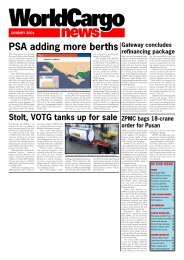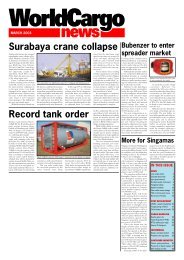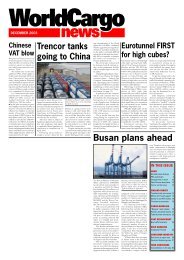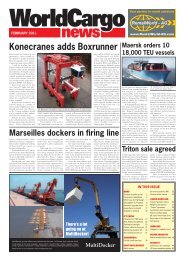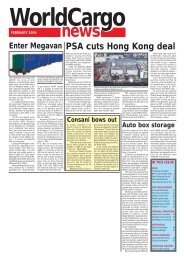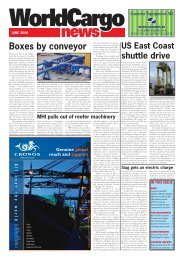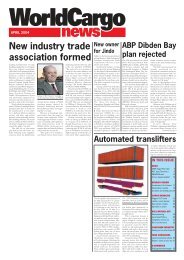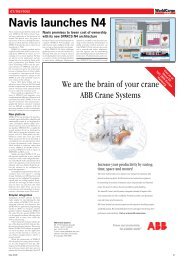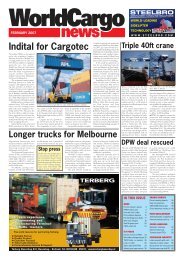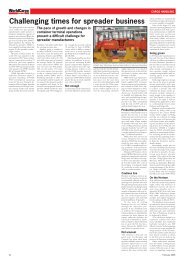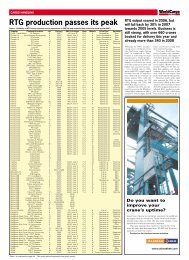Tanjung Priok super port - WorldCargo News Online
Tanjung Priok super port - WorldCargo News Online
Tanjung Priok super port - WorldCargo News Online
Create successful ePaper yourself
Turn your PDF publications into a flip-book with our unique Google optimized e-Paper software.
ICT FOCUS<br />
Collision avoidance on the radar<br />
Positioning system specialist Symeo has<br />
successfully tested a collision avoidance<br />
system at a major straddle carrier terminal<br />
Collision avoidance is on the radar of<br />
several terminal operators looking to<br />
improve safety. Tracking equipment using<br />
GPS to optimise travel paths and<br />
record container moves is relatively<br />
common, but Germany’s Symeo is now<br />
working on a system that uses its Local<br />
Position Radar (LPR) technology to<br />
track equipment for the main purpose<br />
of collision avoidance.<br />
The system design goes beyond establishing<br />
safety zones around equipment<br />
and generating alerts when proximity<br />
is breached. Symeo is focusing<br />
on more comprehensive anti-collision<br />
functionality that uses different sensors<br />
and software-based rules to allow<br />
equipment to operate in close proximity<br />
at slow speeds without generating<br />
unnecessary alarms, while at the same<br />
time raising an alert when a real risk is<br />
imminent.<br />
Lessons from steel mills<br />
Symeo has installed a collision avoidance<br />
system in the hot slab storage area at a<br />
steel mill operated by Voestalpine Stahl<br />
GmbH. It covers cranes, straddle carriers<br />
and other vehicles that operate in a<br />
75,000 m 2 area.<br />
The positioning system consists of<br />
LPR transponders mounted around<br />
the facility as reference points and LPR<br />
radar units on vehicles and cranes. The<br />
position information is used by a Collision<br />
Warning System (CWS), a central<br />
controller similar to the TCAS system<br />
used for airplanes. Machines can determine<br />
any potential collision risks locally<br />
using data from its own position<br />
and from the other equipment.<br />
The vehicles transmit position, speed,<br />
travel direction and their own shape<br />
to other vehicles. The information is<br />
used to calculate a dynamic safety zone<br />
around each vehicle that controls the<br />
warning signals. Drivers have a six-inch<br />
display that shows their vehicle position<br />
and surrounding obstacles and gives<br />
visual and acoustic warnings when<br />
there is a collision danger.<br />
Symeo general manager Christoph<br />
Rommel explained that the system<br />
took some time to configure. It was<br />
initially set up (according to the customer’s<br />
specifications) to provide warnings<br />
based on proximity alone, but this<br />
proved too indiscriminate and generated<br />
too many alarms.<br />
Together with Voestalpine, Symeo<br />
went back and developed specific<br />
warning rules to allow two vehicles to<br />
pass at low speed, and gantry cranes to<br />
work in the same area in tandem without<br />
generating alarms. It is only by taking<br />
this approach, believes Rommel,<br />
that a workable system can be designed<br />
for a complicated environment with<br />
lots of moving equipment like a container<br />
terminal.<br />
Container applications<br />
For a container terminal, said Rommel,<br />
a CWS needs intelligence to identify<br />
parameters including speed and<br />
direction of travel at the vehicle level<br />
and re<strong>port</strong> only those events that constitute<br />
a risk to the central software.<br />
It also needs to integrate information<br />
from quay cranes including trolley<br />
position, spreader height and <strong>port</strong>al<br />
beam height.<br />
Rather than set up alarms based<br />
solely on proximity events, the system<br />
designer needs to work methodically<br />
through all the instances where equipment<br />
comes into close proximity and<br />
define rules around what is safe and<br />
what is not.<br />
A straddle carrier could, for example,<br />
enter the proximity zone of a<br />
crane spreader but not pose a risk if the<br />
spreader is being hoisted.<br />
All terminal traffic patterns have to<br />
be analysed and every fixed obstacle,<br />
including light towers and hatch covers,<br />
must be identified and mapped. The<br />
hardware and software also need to be<br />
configured for different vehicle types,<br />
such as three- and four-high straddle<br />
carriers, that require different safety<br />
rules.<br />
Decentralised system<br />
Symeo does not believe the best way to<br />
design a system is to have a large fleet<br />
of vehicles re<strong>port</strong>ing position and status<br />
constantly to a central application. The<br />
CWS at the steel mill is designed with a<br />
decentralised architecture. “Data is sent<br />
to a server only for replay analysis of<br />
near misses – all collision avoidance decisions<br />
are made locally on the vehicles<br />
and cranes; this minimises the amount<br />
of data that needs to be sent from<br />
equipment to the central software,” said<br />
Rommel.<br />
Each vehicle has a collision zone and<br />
a defined proximity radius. An onboard<br />
collision calculator monitors for obstacles<br />
in the proximity radius, but ignores<br />
other equipment unless their proximity<br />
radii overlap. When that occurs, position<br />
information is sent to the CWS<br />
software on the local machine, which<br />
See us at TOC Europe<br />
at booth B30<br />
triggers an alarm if the operational<br />
rules are breached.<br />
All communication is via triple redundant<br />
ZigBee at 2.4GHz using the<br />
Symeo data protocol. This means, explained<br />
Rommel, that there are no<br />
interference issues with the terminal’s<br />
WiFi network. The system has now<br />
been successfully tested at a container<br />
terminal, it fulfils the customer’s requirements<br />
and implementation is<br />
planned for 2014, said Rommel.<br />
The LPR system can also be leveraged<br />
to provide container position information<br />
and vehicle telematics if required.<br />
GPS has been preferred for this application,<br />
to date, particularly for straddle<br />
carriers, but Rommel believes this<br />
will change. Terminal operators want<br />
one PDS technology that can work<br />
Symeo has installed its system in a German<br />
steel mill and is looking to apply the technology<br />
to container terminals<br />
across the whole terminal, and GPS systems<br />
continually struggle because they<br />
lose signal underneath the quay cranes,<br />
he added. <br />
May 2013 27



